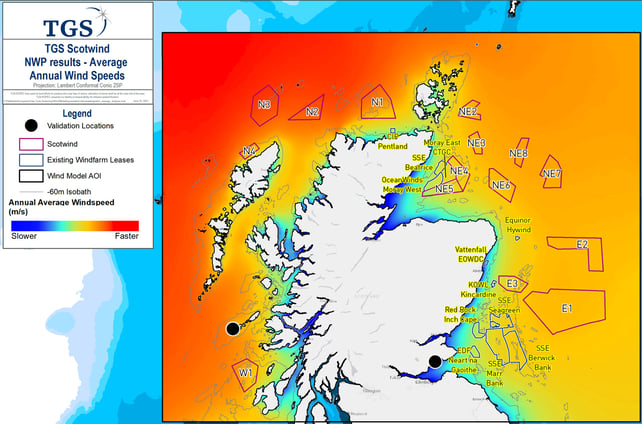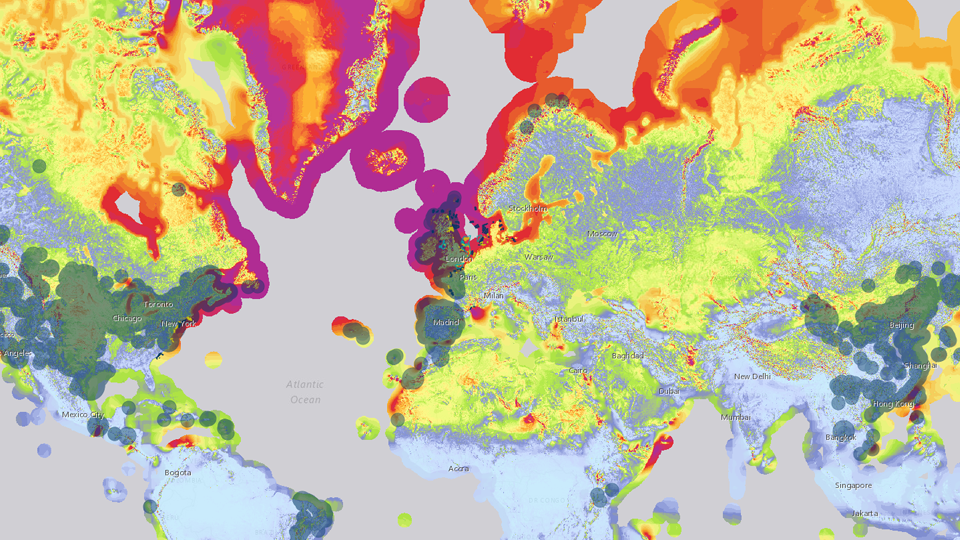

De-Risk Your Wind Investments Today with the Highest-Resolution Wind Energy Dataset
TGS Unique, Ready-to-Use, High-Resolution Numerical Weather Prediction Model
Energy data and insights specialist, TGS, in collaboration with Vaisala, a global leader in weather, environmental, and industrial measurements, presents the most advanced wind energy dataset currently available across the ScotWind leasing areas. This comprehensive numerical weather prediction (NWP) model is designed to reconstruct meteorological conditions from the last 10 years at a spatial resolution of 1km with an hourly temporal resolution, providing operators interested in the ScotWind lease round with a unique, immediately available data resource that can evaluate wind conditions over each block and on a regional basis.
Average wind speeds across the current extent of the TGS' Scottish Wind Energy dataset
Accurate - Dynamic - Trusted
TGS has teamed up with Vaisala to create a model which possesses a higher resolution than publicly available data with coverage over the entirety of offshore Scotland. This enables clients to enhance both their regional models and their understanding of specific ScotWind lease areas.
In addition to being created by industry-approved wind modeling algorithms, crucially this model has been validated by public data to increase the confidence and further improve data quality in comparison with other datasets.
Preliminary Findings
Any Scottish coastal resident is aware that winds are consistently high offshore Scotland. In fact, Scotland has some of the highest mean average wind speeds in the world; leaving the Scotwind lease offer amongst the windiest to have been made available for offshore wind development. It is no surprise then that the mean average wind speed predicted by this model inside the Scotwind lease areas ranges between 9.6 and 10.8 m/s - as a comparison, this model predicts 9.9 m/s inside Equinor’s Hywind Scotland lease area; only one Scotwind lease has a mean average wind speed lower than this.
Compared to model data from the Global Wind Atlas, The TGS model predicts average wind speed to be +0.2 m/s faster in each Scotwind Lease. Summer wind speeds remain relatively high; June averages inside Scotwind leases range from 7.2-8.6 m/s. In winter, the highest December mean average windspeed inside Scotwind touches 13.4 m/s. All windspeeds quoted at a height of 100m, the same hub height as a Hywind turbine.
This Initial analysis further emphasizes the need for additional wind energy insight within this region and is one reason why TGS has made this dataset available for licensing immediately. Please use the form on the side of this webpage or contact phillip.hargreaves@tgs.com directly.
Energy Insights Expertise
TGS has been supplying the energy industry with insights to enhance operations for over 40 years. We have long-standing, well-respected experience in curating huge amounts of energy data and extracting key intelligence. Product development partnerships such as that formed with wind modeling experts Vaisalla, allow TGS to apply their data expertise to a wider range of energy sectors and introduce new products and technologies to enhance data-driven insight within that sector.
High-Resolution Numerical Weather Simulations
The TGS NWP model has utilized Vaisala’s Wind Energy Weather Modeling Technology. This model produced the lowest combined mean absolute error in a benchmarking test of 20 modeling techniques by the American Wind Energy Association (AWEA) and also outperformed rivals through specific 'stress testing' in challenging conditions.
The Vaisala method relies on a combination of advanced mesoscale numerical weather prediction (NWP) computer modeling, innovative and efficient microscale wind modeling, and proprietary algorithms to identify and combine the best information from the model output and client-provided wind measurements at the wind project site.
Actual weather events across the survey area are represented through mesoscale NWP models which include synoptic-scale weather systems (high and low pressure centers, fronts, upper and lower-level jets); thunderstorms and squall lines; monsoonal circulations; land-sea-breeze circulations; mountain-valley circulations; mountain waves; and topographic gap flows. In addition to topographical effects, these phenomena, when averaged over long time periods, can signify crucial spatial patterns or gradients of wind flow.
Unlike conventional methods that apply linear flow models, or Computational Fluid Dynamics (CFD) models, that derive their wind inputs from only a single point and therefore capture only the locally driven modifications to the wind field, this model is able to emulate regional meteorologically driven variations. This is achieved through mesoscale model simulation configured with an outer domain of many hundreds of kilometers around the area of interest, with nested domains of increasing resolution.
This approach allows the NWP model to fully represent atmospheric stability variations, through their use of the full Navier-Stokes equations and treatment of all relevant physical processes, including heating and cooling associated with the diurnal cycle, and turbulent mixing within the planetary boundary layer.
Mesoscale models predict stability, which has a strong influence on the wind profile in the lowest several hundred meters of the atmosphere, accounting for its effect not only on turbulent mixing but also its “buoyancy effect” on the vertical air motions in more organized circulation patterns. Typical CFD models do not reach this level of sophistication.
Product Specifications
| Spatial Resolution | 2km WRF with 1km TVM downscaling |
| Analysis Time Frame | 10-years: January 2011 to current |
| Temporal Resolution | Hourly |
| Hub Heights | 80m, 100m, 120m, 140m, 160m, 180m |
| Deliverables | Mean maps and gridded time series NetCDF files delivered via FTP in standard format. |
|
Maps:
NetCDF variables:
|
|
| Modeled domain area |
542.2 km x 424.7 km (230265.5 km2) |
Additional Resources

Useful Links
- SUBSCRIBE to our NES Updates e-Newsletters for daily updates relevant to your industry
- EXPLORE our unique, interactive Pathfinder apps to de-risk your next New Energy venture
- DISCOVER more information on our offshore wind energy data solutions
Contact us to learn more about our Scottish Wind Energy Dataset or other Wind Energy Solutions